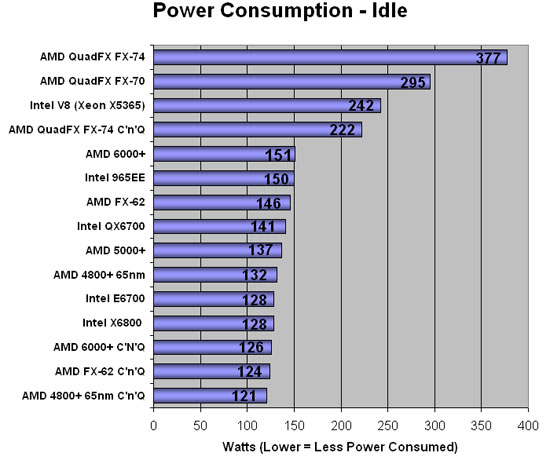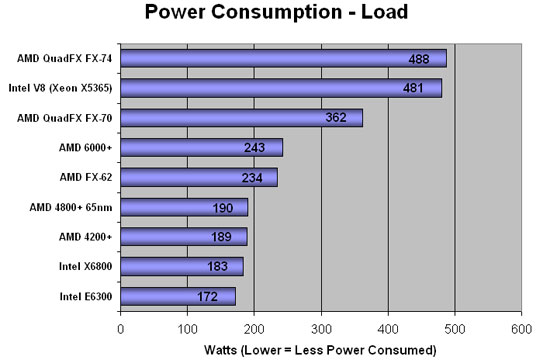Intel’s Mighty Dual Xeon Beast – V8 Platform Preview
Power Consumption
Since power consumption is a big deal these days, we ran some simple power consumption tests on our test beds. Both systems ran with the same memory, power supplies, case fan, video card and hard drive model. To measure idle usage, we ran the system at idle for one hour on the desktop with no screen saver and took the measurement.

When it came to idle power consumption, the AMD Athlon 64 X2 6000+ consumed the more than any of the other processor on a single socket platform that we tested. By enabling AMD’s CoolnQuiet feature we were able to go from consuming the most to nearly the least amount of power! AMD really has made strides with idle and power consumption for those that enable CoolnQuiet (CnQ in the charts) in Windows. AMD’s 65nm Brisbane-based 4800+ processor took the overall lead when it came to having the best power consumption. When it comes to the QuadFX and V8 systems, these dual socket platforms obviously consume more power as they have another power hungry processor to keep running. Another reason for the large jump up is due to the chipsets that the motherboards use on the QuadFX and V8 platforms, so remember not all the Watt increase is due to the CPU alone.

The core voltage on the Intel Xeon 5365 processor is 1.4125V, which is high compared to other Core 2 desktop ptocessors. Actually, this is a higher Vcore of any other existing processors with Core micro-architecture. As a result, the typical heat dissipation of Xeon X5365 has also increased to an all time high of 150W. This high heat dissipation reminds us of the times of NetBurst, at least in the server segment, especially since the TDP of those Xeon processors didnt exceed 130W. The TDP on the Xeon 5365 is 150W while the Xeon 5355 processor has a TDP of only 120W. Even with a TDP of 150W each the pair of Xeon 5365 processors consumed less power than the AMD QuadFX FX-74 system that just happened to also be running 3GHz processors. Intel suggests using at least an 850W power supply when building a system like their ‘V8’ demo machine and seeing how we are reaching 500W without putting a load on the GPU this is great advice.
**TIP** If you are interested in saving even more money every month try switching to an Active PFC power supply!

Comments are closed.